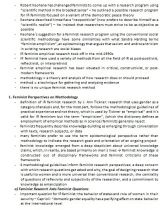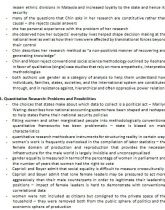Hledej
Zobraz:
Univerzity
Kategorie
Rozšířené vyhledávání
12 662
projektů
Home » Studijní materiál » What is Your Research Program? Some Feminist Answers to International Relations Methodological Questions
What is Your Research Program? Some Feminist Answers to International Relations Methodological Questions
| Přípona .doc |
Typ studijní materiál |
Stažené 0 x |
| Velikost 0,1 MB |
Jazyk anglický |
ID projektu 9380 |
| Poslední úprava 09.01.2017 |
Zobrazeno 1 262 x |
Autor: clean.bandit |
 Sdílej na Facebooku
Sdílej na Facebooku |
||
| Detaily projektu | ||
- Cena:
4 Kreditů - kvalita:
87,2% -
Stáhni
- Přidej na srovnání
- Univerzita:Univerzita Karlova v Praze
- Fakulta:Fakulta sociálních věd
- Kategorie:Humanitní vědy » Politologie
- Předmět:Mezinárodní vztahy
- Studijní obor:-
- Ročník:3. ročník
- Formát:MS Office Word (.doc)
- Rozsah A4:5 stran
- Robert Keohane has challenged feminists to come up with a research program using “scientific method in the broadest sense” - he outlined a possible research program for IR feminists focused on a variant of the democratic peace theory
- Keohane described himself as a “neopositivist” (now prefers to describe himself as a “scientific realist”) - he insisted that researchers must strive to be as objective as possible
- Keohane´s suggestion for a feminist research program using the conventional social scientific methodology have some similarities with what Sandra Harding terms “feminist empiricism”, an epistemology that argues that sexism and androcentricism in existing research are social biases
- IR feminist empirical research took off in the mid-1990s
- IR feminist have used a variety of methods from all the field of IR as post-positivist, reflectivist, or interpretivist
- feminist empirical research has been situated in critical, constructivist, or post-modern frameworks
- methodology = a theory and analysis of how research does or should proceed
- method = a technique for gathering and analyzing evidence
- there is no unique feminist research method
- Keohane described himself as a “neopositivist” (now prefers to describe himself as a “scientific realist”) - he insisted that researchers must strive to be as objective as possible
- Keohane´s suggestion for a feminist research program using the conventional social scientific methodology have some similarities with what Sandra Harding terms “feminist empiricism”, an epistemology that argues that sexism and androcentricism in existing research are social biases
- IR feminist empirical research took off in the mid-1990s
- IR feminist have used a variety of methods from all the field of IR as post-positivist, reflectivist, or interpretivist
- feminist empirical research has been situated in critical, constructivist, or post-modern frameworks
- methodology = a theory and analysis of how research does or should proceed
- method = a technique for gathering and analyzing evidence
- there is no unique feminist research method
Klíčová slova:
feminist
methodology
research
emancipation
quantitative research
possibilities
Obsah:
- 1. Feminist Perspectives on Methodology
a) Feminist Research Asks Feminist Questions
b) Use Women´s Experiences to Design Research that is Useful to Women
c) Reflexivity
d) Knowledge as Emancipation
2. Using these Methodological Guidelines: Some Feminist Examples
a) Sex Among Allies
b) In Service and Servitude
3. Quantitative Research: Problems and Possibilities
4. Conclusion

